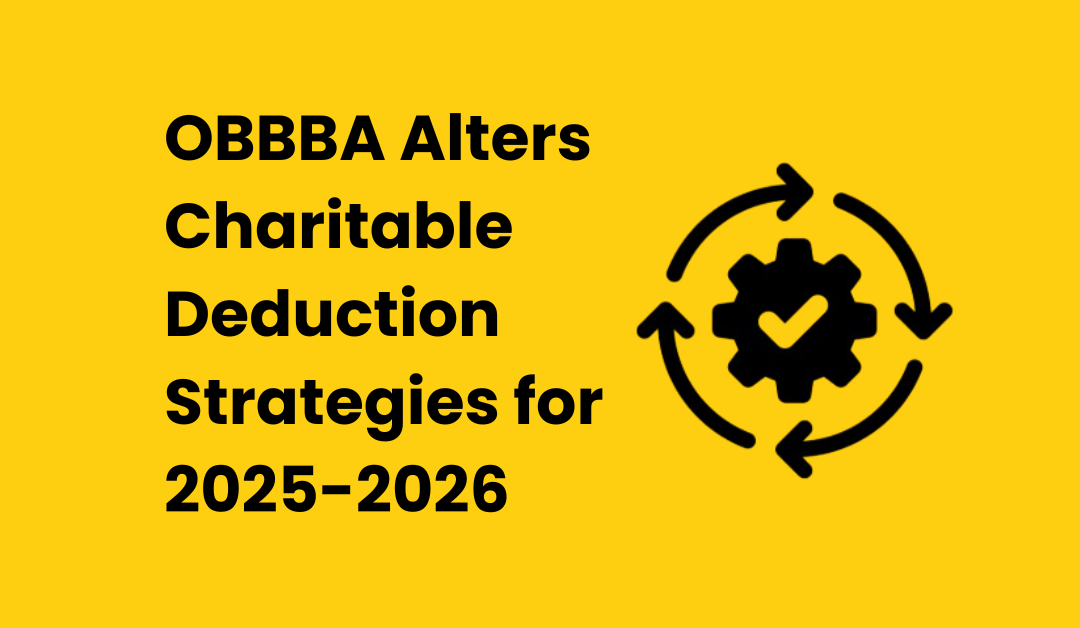Charitable giving is a cornerstone of many tax-planning strategies — but with the passage of OBBBA, the landscape for deductions tied to philanthropy is shifting. For high-net-worth individuals, tax professionals, and CPAs advising clients, understanding these changes is critical. In this blog we’ll walk through how the new rules affect charitable contributions in tax years 2025 and 2026, highlight key timing strategies, and explain why leveraging a tool such as Hive Tax AI can give you an edge in planning and decision-making.
What’s Changing with OBBBA and Charitable Deductions
Here are the major deductible-charitable-giving changes under OBBBA:
- Beginning in tax year 2026, individuals who itemize deductions will face a 0.5% of AGI floor on charitable contributions: only the portion of contributions above 0.5% of adjusted gross income (AGI) will be deductible.
- Also beginning in 2026, for taxpayers in the highest marginal federal income-tax bracket (37 %), the value of itemized deductions is effectively capped so that the deduction benefit is limited to 35 % rather than 37%.
- The 60%-of-AGI limit for cash contributions to public charities (originally under the Tax Cuts and Jobs Act) is now made permanent.
- For taxpayers who do not itemize, a new above-the-line charitable deduction becomes available in 2026: up to $1,000 for single filers and $2,000 for joint filers for cash gifts to public charities (not donor-advised funds).
Why 2025 Is a Critical Year for Charitable Giving
Because many of the new limitations don’t take effect until 2026, tax year 2025 presents an opportunity:
- Contributions made in 2025 are still subject to the existing (more favorable) rules: no 0.5%-of-AGI floor yet, no 35% cap for 37% bracket yet.
- That means clients who plan a large charitable gift may accelerate it into 2025 (even if distributed later) to lock in the more generous deduction. For example: a taxpayer in the 37% bracket with a $1 M AGI making a $100 k gift—if done in 2025, full deduction value; if delayed to 2026, deduction benefit shrinks.
- Using tools like a donor-advised fund (DAF) allows giving in 2025 (to lock the deduction) while spreading grants to charities over future years.
Practical Strategies for Tax Planning
Here are actionable strategies for clients and advisors:
- Front-load (bunch) charitable contributions into 2025 especially for high-income donors. Because the new floor and cap hit in 2026, doing the giving earlier maximizes the deduction.
- Consider donor-advised funds (DAFs) as the vehicle: make a one-time contribution in 2025 to take the deduction now, while retaining flexibility to grant funds in later years.
- Evaluate itemizing vs standard deduction years: With the new non-itemizer deduction (in 2026), some clients may prefer to not itemize. Use 2025 to push deductions into the itemizing year if beneficial.
- Monitor AGI levels and marginal tax brackets: High-AGI clients may face the deduction floor and cap more severely; reducing AGI or shifting giving years could help.
- Donations of appreciated stock or complex assets remain tax-efficient; making these contributions in 2025 avoids the new more restrictive rules.
- Communicate the change clearly to clients: after 2025 the “full” deduction will be trimmed, so early planning is essential.
How Hive Tax AI Fits In
In the evolving tax-law environment, advanced tools like Hive Tax AI bring real value:
- Research efficiency: Hive Tax AI can parse the OBBBA provisions rapidly, summarise how the 0.5% floor and 35% cap apply, and generate scenarios for various AGI and gift-levels.
- Scenario-modeling: By inputting client data (AGI, planned donation, bracket, timing), Hive Tax AI can project deductible amount under current law vs post-2026 law.
- Content generation: Tax professionals using Hive Tax AI can quickly create client-facing guidance, advisory memos, or blog posts (like this one) that highlight the charitable-giving strategy change.
- Knowledge-base integration: As your tax-research tool, Hive Tax AI supports the tax professional’s workflow by keeping up-to-date on OBBBA, charitable deduction rules, and preparing alerts and checklists.
In short: when charitable deduction rules shift, having an AI-powered platform like Hive Tax AI helps your firm stay ahead, provide value to clients, and capture strategic opportunities.
Summary
The passage of OBBBA ushers in material changes to how charitable deductions work for both itemizers and non-itemizers. With a 0.5% of AGI floor, a 35% cap for top-bracket donors, and new rules for standard-deduction filers, the rules beginning in 2026 require careful planning now. For advisers, the take-away is clear: act in 2025 to capture the more generous deduction environment, use strategies such as bunching and donor-advised funds, monitor client AGIs and marginal tax brackets, and leverage platforms like Hive Tax AI to model, monitor and document scenarios.

